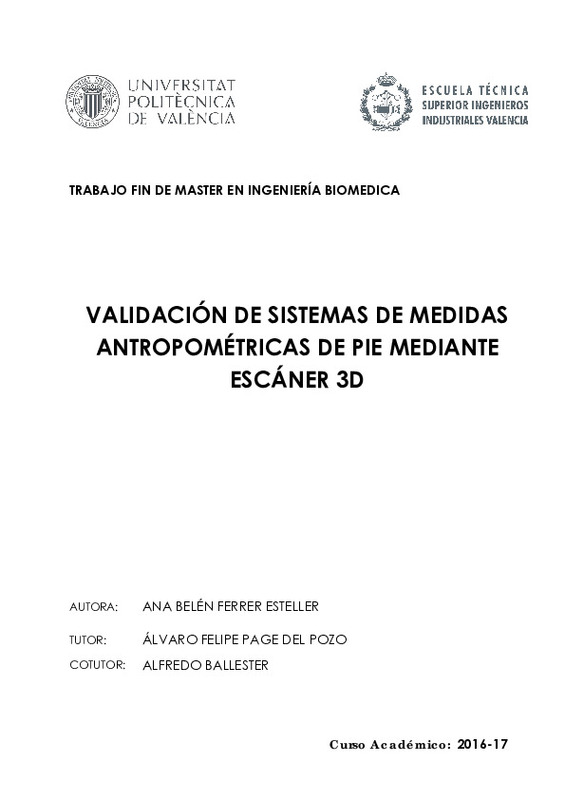|
Resumen:
|
[ES] En este Trabajo de Fin de Master se estudió la validación de dos nuevas técnicas de escaneado 3D para antropometría del pie desarrolladas por el Instituto de Biomecánica de Valencia. Éstas son: la aplicación móvil ...[+]
[ES] En este Trabajo de Fin de Master se estudió la validación de dos nuevas técnicas de escaneado 3D para antropometría del pie desarrolladas por el Instituto de Biomecánica de Valencia. Éstas son: la aplicación móvil AVATAR 3D y el equipo DOMEscan, sistemas de escaneado basado en la fotografía y que, mediante un software propio, permiten la reconstrucción del pie en 3D a partir de información 2D. Además, proporcionan en menos de 1 minuto las medidas de 22 dimensiones del pie.
Para ello, primero se realizó un estudio de fiabilidad de ambas técnicas mediante el cálculo del Coeficiente de Correlación Intraclase (ICC) y el error asociado tanto al DOMEscan como para la aplicación móvil, resultando que los valores de fiabilidad eran elevados en los dos casos y por lo tanto estos sistemas median bien las variables estudiadas, proporcionando así, valores de repetitividad y precisión adecuados para procesos de asignación de talla.
Cuando se finalizó el estudio de fiabilidad, se procedió al estudio de validez, donde se valoraron las discrepancias entre las medidas obtenidas entre las técnicas antropométricas desarrolladas con las de las medidas manuales, un método tradicional y comúnmente utilizado en la antropometría de pie. De este estudio, se obtuvo que tanto el DOME como el AVATAR 3D eran técnicas válidas y que, por lo tanto, se presentan como alternativas sencillas, baratas y rápidas en la antropometría del pie.
[-]
[EN] In this Master's Final Project, it was studied the validation of two new 3D scanning techniques for the foot anthropometry that were developed by the Biomechanics Institute of Valencia. These are: the AVATAR 3D mobile ...[+]
[EN] In this Master's Final Project, it was studied the validation of two new 3D scanning techniques for the foot anthropometry that were developed by the Biomechanics Institute of Valencia. These are: the AVATAR 3D mobile application and the DOMEscan device, photo-based scanning systems and which, through their own software, allow the reconstruction of the 3D foot from 2D information. In addition, they provide measurements of 22 foot dimensions in less than one minute.
For this, a reliability study of both techniques was performed at first by calculating the Intraclass Correlation Coefficient (ICC) and the error associated with both the DOMEscan and the mobile application, resulting in high reliability values in both cases. Therefore, these systems measured well the variables studied thus providing adequate repeatability and accuracy values ¿¿for size allocation processes.
When the reliability study was completed, the validity study was carried out, where the discrepancies between the measures obtained between anthropometric techniques developed with those of manual measurements, a traditional method commonly used in foot anthropometry, were evaluated. From this study, it was obtained that both DOME and AVATAR 3D were valid techniques and, therefore, presented as simple, inexpensive and fast alternatives to foot anthropometry.
[-]
|







